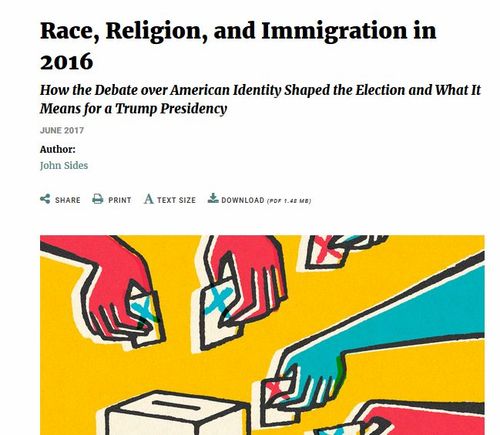From the Voter Study Group:
Race, Religion, and Immigration in 2016It’s interesting how the less educated tend to be more aware. It’s almost as if education today serves to indoctrinate people to be oblivious to the obvious.How the Debate over American Identity Shaped the Election and
What It Means for a Trump Presidency
JUNE 2017 Author:John Sides
… Second, drawing on reinterviews of Americans originally interviewed in 2011 to 2012, I show that attitudes about immigration, feelings toward black people, and feelings toward Muslims became more strongly related to voter decision making in 2016 compared to 2012. None of the other factors that I examine show this pattern. The greater salience of attitudes related to race, ethnicity, and religion arguably derives from a campaign far more focused on immigration and the threat of terrorism than the 2012 campaign was.
Finally, I describe the contours of Americans’ opinions about key facets of the immigration debate. I show that Trump’s initial priorities of restricting immigration and fighting terrorism align very much with the priorities of Republican voters and especially his base of primary supporters. Moreover, there are large partisan cleavages in how Americans feel about both immigrants and Muslims, with Republicans and especially Trump primary supporters expressing less favorable views of these groups, on average. …
The Democratic Party has an increasing advantage among nonwhite people. … By contrast, the Republican Party has an increasing advantage among white people—an advantage that only developed after Obama took office. …
The figure shows that white flight from the Democratic Party occurred almost entirely among white people without a college degree….
This alignment between partisanship and racial attitudes involved more than attitudes toward black people. By 2012, white Democrats and white Republicans diverged over whether they evaluated Muslims favorably and whether immigration should be restricted. Depending on the specific survey question, this divergence consists of Democrats moving toward more favorable attitudes, Republicans moving toward less favorable attitudes, or both.In other words, more than a few white people who voted for Obama in 2012 held views that were too realistic for Hillary in 2016.In December 2016, the survey firm YouGov reinterviewed 8,000 respondents who had been interviewed originally in 2011 to 2012 as part of the Cooperative Campaign Analysis Project. ….
What stands out most, however, is the attitudes that became more strongly related to the vote in 2016: attitudes about immigration, feelings toward black people, and feelings toward Muslims. …
The increased salience of these attitudes was particularly helpful for Trump because there were a substantial number of white Obama voters who as of late 2011 had less favorable attitudes toward black people, Muslims, and immigrants. For example, 37 percent of white Obama voters had a less favorable attitude toward Muslims (a feeling thermometer score on the “cooler” side of the scale). Similarly, 33 percent of white Obama voters said that “illegal immigrants” were “mostly a drain,” compared to 40 percent who said that they “mostly make a contribution” (the rest said “neither” or were not sure). About 34 percent said that it should be harder “for foreigners to immigrate to the United States,” while just 33 percent said it should be easier and 21 percent said there should be no change. By comparison, only 6 percent of white Romney voters thought illegal immigrants make a contribution to American society; the vast majority, nearly 80 percent, thought that these immigrants were a drain. Obama also won votes from some white people with unfavorable views of black people. …
The VOTER Survey asked respondents about four potential consequences of these demographic changes:It’s interesting how nobody ever asks about how immigration and affirmative action interact. You are just not supposed to think about how the U.S. keeps importing more people who, as soon as they land, are entitled to racial privileges that come at your expense.Now, as you may know, census projections show that by 2043, black people, Latinos, Asians, and other mixed racial and ethnic groups will together be a majority of the population. Thinking about the likely impact of this coming demographic change, how much do you agree or disagree with each of these statements? • Americans will learn more from one another and be enriched by exposure to many different cultures. • A bigger, more diverse workforce will lead to more economic growth. • There will be too many demands on government services. • There will not be enough jobs for everybody.
Respondents were more optimistic than pessimistic: larger majorities agreed that demographic change would produce cultural enrichment (75 percent) and economic growth (73 percent) than agreed that there would be too many demands on government services (56 percent) or not enough jobs (52 percent). At the same time, that at least half of Americans agreed with each statement suggests ambivalence about the impact of these demographic changes.It’s striking how the Democrats by 2016 were the party of Status Quo Triumphalism and Complacency.Views of the Consequences of a Majority-Minority Nation There were divisions between the parties: Democrats were more optimistic than Republicans, and Trump primary supporters were generally the least optimistic. For example, 59 percent of Republicans, compared to 89 percent of Democrats, thought that a majority-minority nation would enrich Americans by exposing them to different cultures. The largest difference concerned the potential demands on government services: only 33 percent of Democrats agreed with this, but 80 percent of Republicans and 84 percent of Trump primary voters agreed.












